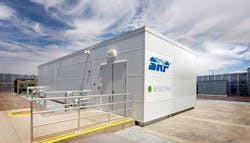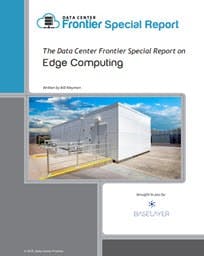Deploying Real-World Edge Solutions: A Lego-Inspired Design Approach
This is the final entry in a four-part Data Center Frontier special report series that explores edge computing from a data center perspective. This post covers some of today’s edge solutions, including BASELAYER’s modular approach.
Download the full report.
Edge design really does come down to your use-case and what you’re trying to accomplish. We are now entering the brave new world of flexible data center infrastructure. Where dedicated infrastructure can be put closer to eyeballs. Data center infrastructure may be called upon to deliver different performance characteristics in different markets. It may be subject to different security requirements, different redundancies, different cooling requirements and opportunities, etc. The possible requirements are almost endless.
And from a practical operating perspective, the key problem in implementing and operating an edge deployment is the fact that it is at the edge. Lights-out, remote deployments. While the data center(s) may not be necessarily “remote” in terms of an out-of-the-way location, it most certainly will be outside the practical operating radius of daily operations management resources. And you can’t do your daily floor walk. You can’t see or hear or smell what’s going on in the data center. You don’t have the luxury of always having somebody to conduct a visual inspection in 10 minutes.
The challenge now becomes how to achieve capital cost effectiveness, operating efficiency, operational consistency across geographies, deployment consistency, and reliably predictable deployment timeframes.
So how does modularity address all of this? To answer that question, let’s take a look at one modular solution provider, Baselayer, to see how they have solved some of these real issues of moving capacity to the edge.
Baselayer
Baselayer has addressed these needs through its family of Edge solutions and products.
BASELAYER was spun off from its former parent, IO Data Centers, in 2015. Prior to its sale to Iron Mountain in early 2018, IO was the second largest privately held colocation services provider in the world, with a 200MW footprint in North America, Europe, and Asia. BASELAYER’s designs therefore come from within the industry, and are engineered by a team that has decades of cumulative data center operating experience. As CEO and co-founder Bill Slessman says, “When we were in the colocation business, our job didn’t end when the data center modules were commissioned, it was only beginning. We had to actually operate what we ourselves were manufacturing, and we had to do so for years. Data center operating responsibility breeds a different level of concern and intensity about module design, engineering, and quality. A tin box shipping container was simply not something we were willing to bet our reputation as operators on.”
Standard design, flexible in combination to fit user requirements:
- Modules are standard in design, but flexible in combination, to allow flexibility in deployment according to user requirements and local conditions
- Flexible according to need — 50kW to 5MW and above, alternate cooling designs, higher cabinets, higher density
- Rapid deployment
- Consistent equipment and operating routines throughout entire footprint — modular design, family of products
Cost effectiveness:
- Economics made possible by manufacturing
- Lego-like, building block approach allows flexibility in design with a manufactured solution, versus cost-prohibitive stick-built custom solutions
- We make the same data center, over and over and over and over again
BASELAYER EDGE X2 modular data center (Source: BASELAYER)
Security
- Modules are secure — with visual monitoring, intrusion detection, fire detection and suppression
- Indoor/outdoor deployment
As BASELAYER’s Chief of Staff, Samir Shah, likes to say, “Our modules are not ruggedized — it’s not an afterthought, they’re rugged by design,” and are made of robust, welded steel frames.
Visibility
- RunSmart, a SaaS application developed by the Baselayer team
- Integrated software allows for viewing numerous operating metrics, warning signals, custom thresholds, preventive maintenance schedules
- While no longer have the “security blanket” of a visual inspection or fly-by, the track record of operating metrics is far more reliable and less subject to variability in observation
Operational response
- BASELAYER’s installation, maintenance, and services team. An integrated solution through the lifetime of the data center.
You can start smaller and work with the BASELAYER EDGE X2 modular data center. This unit delivers up to 75kW of critical IT power and cooling for up to seven (7) 52U racks. Here’s what else it can do:
- Engineered to meet NEMA 4 compliance standards for deployment in all global environments
- Ships configuration-tested from the factory with RunSmart Embedded providing access to key module sensors and controls via a web-based server
- Power and cooling redundancy thresholds are configurable through BASELAYER® RunSmart
BASELAYER XA50 Data Module Intelligence around the edge — working with
management and powerful software solutions. (Source: BASELAYER)
Or, you can go bigger edge with XA50 Data Module which delivers up to 500kW of critical IT power and cooling for up to one hundred ten (110) 52U racks. This is where that ‘Lego’ concept really comes into play. It also allows for a variety of cooling capabilities all in the same form factor. Giving enterprises the ultimate in flexibility as they deploy on the edge.
The critical nature of edge computing requires you to work with solutions that deliver seamless connectivity, streamlined configuration, and integrated views down to the smallest details of your new edge data center. BASELAYER’s solution, RunSmart allows you to safely and securely monitor, track, and maintain the core aspects of your infrastructure anytime, on any device, from anywhere in the world on a single unified console.
You can use advanced workflow engines to add automation to your operation as well. RunSmart is a powerful edge management solution that also allows you to forecast requirements.
This type of management framework allows you to do quite a bit with your edge data center.
For example:
- Cloud Deployed, SaaS Enabled, Intelligent Vision. Taking a lesson from where IT is going, RunSmart pushes the boundaries of traditional DCIM offerings living on the edge. You’re literally enabling the next-generation of intelligent data center edge monitoring. RunSmart is hosted in the Cloud (i.e. Azure) and priced on a monthly subscription ideally for distributed infrastructure assets. This isn’t just deploying a piece of software. You’re now leveraging a powerful consumption model that can shift with your edge requirements.
- Integrated Module Views. RunSmart provides transparency into the metrics that matter to you, such as utilization, cost, health, and sustainability of your modular data center. With functional and reliable dashboards that provide detailed views into operations, asset management, capacity planning, server metrics and more.
- Connecting Your Devices. Monitoring doesn’t stop at the Module, add your global infrastructure to RunSmart and intelligently monitor traditional data centers, chiller plants, generators, power distribution systems, or other Building Management Systems. Gain a holistic view of your operation and allow RunSmart to show you a smarter way to manage your infrastructure.
- Powerful Add-Ons. Elevate the performance of your datacenter, no matter where it is, with advanced features from RunSmart. Utilize our proprietary workflow and integrated graphic engines to predict the future needs of your organization, trend key indicators, report inefficiencies, and automate processes & alerts to decision makers for accountability. Additionally, leveraging capabilities inherent Azure IoT Hub, users have access to hundreds of software extensions already integrated into the Cloud workflow.
Finally, a powerful edge management solution doesn’t just help you manage edge in real-time. It allows you to forecast requirements and do so much more. With these types of edge control methods, you can leverage advanced workflow engines to add automation to your operation as well.
This Data Center Frontier series, focused on edge computing, also covered the following topics:
- New Ways to Deploy Edge Capacity for Data Center Leaders
- Understanding the Edge and the World of ‘Connected Devices’
- How to Leverage True Edge Flexibility and Where to Overcome Operational Challenges
Download the full Data Center Frontier Special Report on Edge Computing, courtesy of BASELAYER. The full report also includes an Edge solutions decision-making checklist.
Explore the evolving world of edge computing further through Data Center Frontier’s special report series and ongoing coverage.
About the Author



